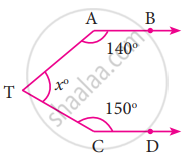Advertisements
Advertisements
प्रश्न
In the given figure, BI is the bisector of ∠ABC and Cl is the bisector of ∠ACB. Find ∠BIC.
उत्तर
In Δ ABC,
BI is the bisector of ∠ABC and CI is the bisector of ∠ACB.
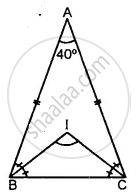
∵ AB = AC
∴ ∠B = ∠C ............(Angles opposite to equal sides)
But ∠A = 40°
and ∠A + ∠B + ∠C = 180° ......(Angles of a triangle)
⇒ 40° + ∠B + ∠B = 180°
⇒ 40° + 2 ∠B = 180°
⇒ 2 ∠B = 180° − 40° = 140°
⇒ ∠B =`(140°)/2=70°`
∴ ∠ABC = ∠ACB = 70°
But BI and CI are the bisectors of ∠ABC and ∠ACB respectively.
∴ ∠IBC =`1/2` ∠ABC =`1/2(70°)=35°`
and ∠ICB =`1/2` ∠ACB =`1/2xx70°=35°`
Now in Δ IBC,
∠BIC + ∠IBC + ∠ICB = 180° ........(Angles of a triangle)
⇒ ∠BIC + 35° + 35° = 180°
⇒ ∠BIC + 70° = 180°
⇒ ∠BIC = 180° − 70° = 110°
Hence ∠BIC = 110°
APPEARS IN
संबंधित प्रश्न
Find the unknown angles in the given figure:
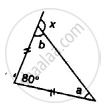
Apply the properties of isosceles and equilateral triangles to find the unknown angles in the given figure:

In an isosceles triangle, each base angle is four times its vertical angle. Find all the angles of the triangle.
The vertical angle of an isosceles triangle is 15° more than each of its base angles. Find each angle of the triangle.
The base angle of an isosceles triangle is 15° more than its vertical angle. Find its each angle.
The vertical angle of an isosceles triangle is three times the sum of its base angles. Find each angle.
The ratio between a base angle and the vertical angle of an isosceles triangle is 1: 4. Find each angle of the triangle.
Find x in Figure Given: DA = DB = DC, BD bisects ∠ABC and∠ADB = 70°.
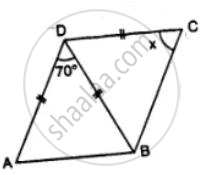
In the figure, given below, ABCD is a square, and ∆ BEC is an equilateral triangle. Find, the case:∠BAE
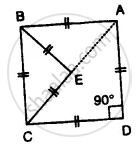
In the figure, AB is parallel to CD, find x